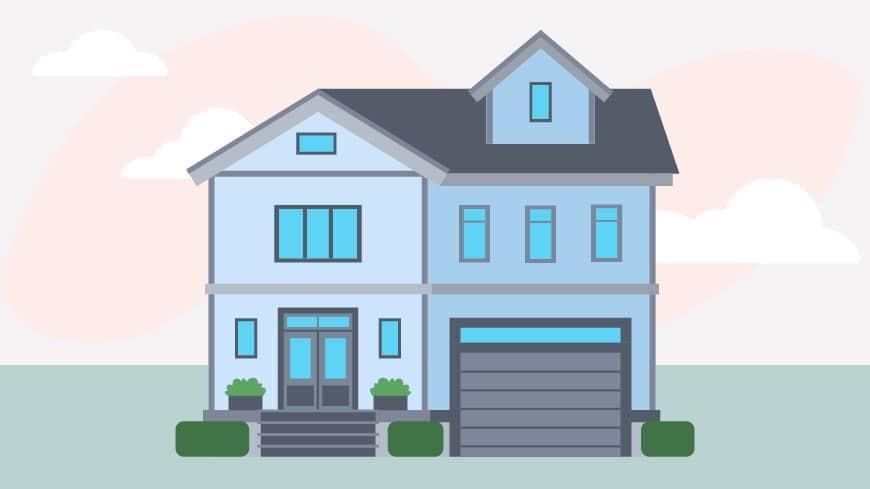What is Loan-to-Value Ratio for a Mortgage?

Let’s face it—mortgage loans can feel overwhelming, especially when you hear terms like Loan-to-Value ratio. What does it even mean, and how does it affect your dream home?
We’re about to demystify the LTV ratio, explain how it works, and what you can do to improve it if needed. Understanding your LTV ratio is crucial when applying for a mortgage or considering refinancing options.
Ready to take the first step? Get pre-approved for a mortgage today with Rate’s fast and easy digital application process.
What is Loan-to-Value Ratio (LTV)?
The Loan-to-Value (LTV) is a simple percentage that shows how much of your home’s value is financed by your mortgage. Here’s the formula:
LTV = (Loan Amount / Appraised Property Value) × 100
For example, if you’re buying a home worth $250,000 and you need a $200,000 loan, your LTV would be 80%.
How Does LTV Ratio Impact a Mortgage?
Let’s break down the key ways LTV impacts a mortgage and what it means for your home buying or refinancing journey.
LTV and Mortgage Eligibility
When applying for a mortgage, lenders assess your financial situation through a process called underwriting.
This involves looking at your debt-to-income ratio and other factors to determine your ability to manage mortgage payments alongside your other financial obligations, such as credit cards or auto loans.
What Does 80% LTV Mean?
Lenders typically prefer borrowers with an LTV ratio under 80%, as it indicates you’ve made a substantial down payment or built up considerable equity in your home.
This reduces the lender’s risk because if you default, they can more easily recover their money by selling the property.
LTV and Interest Rates
For most conventional loans, you can qualify for lower interest rates if your LTV ratio is below 80%. This can save you thousands of dollars over the life of the loan.
How Does a High LTV Ratio Affect my Mortgage Interest Rates?
A high LTV ratio, on the other hand, means the lender may charge a premium on your mortgage rates to compensate for the increased risk.
LTV Ratio and Private Mortgage Insurance (PMI)
If your LTV ratio is above 80%, you’ll probably be required to pay for Private Mortgage Insurance (PMI). PMI can add hundreds of dollars to your monthly payments, and it’s not something most homeowners look forward to.
The good news is that you don’t have to pay PMI forever. Once your LTV drops below 80%—either through making extra payments or due to your home’s value increasing—you can request to have PMI removed.
While the process might take some time, it’s worth it to reduce your overall monthly payments.
LTV Ratio and Refinancing
Your LTV ratio can also play a big role when you want to refinance your mortgage. Lenders typically require an updated appraisal to calculate your new LTV ratio and determine your eligibility for refinancing.
If your LTV ratio is lower, you’ll likely qualify for a standard refinance, which could reduce your interest rate or loan term. You may even be able to refinance to remove PMI if your LTV has dropped below 80% since purchasing your home.
If your LTV ratio is higher than 80%, your options may be more limited, but government-backed programs like the FHA streamline refinance or VA Interest Rate Reduction Refinance Loan (IRRRL) can still help.
LTV Ratio and Home Equity
Your LTV ratio also reflects the amount of equity you have in your home. The lower your LTV, the more home equity you have.
For example, if your home is worth $300,000 and you owe $150,000, your LTV ratio is 50%, meaning you have 50% equity in your home.
This equity can be leveraged through home equity loans or home equity lines of credit (HELOCs), allowing you to borrow against your home’s value. You can use this equity for home improvements, debt consolidation, or other financial needs.
How Can I Calculate My LTV Ratio?
Calculating your Loan-to-Value (LTV) ratio is easier than you might think. Here’s a step-by-step calculation:
Step-by-Step Calculation
Let’s say you’re taking out a $150,000 loan on a home that’s appraised at $200,000. The formula is:
LTV = ($150,000 / $200,000) × 100 = 75%
In this case, your LTV ratio is 75%, which is under the magic 80% threshold that most lenders prefer for avoiding Private Mortgage Insurance (PMI).
Tools and Resources for LTV Calculation
If you’re not a math whiz or just want a quick answer, there are plenty of resources out there to help you calculate your LTV ratio accurately.
For example, Rate’s mortgage calculator makes it easy to plug in your loan amount and property value to get your LTV in seconds. You could also speak to a personal finance expert for personalized guidance.
Common Pitfalls When Calculating LTV
Here are some pitfalls to avoid when calculating your LTV ratio:
Using an Outdated Property Value
Real estate markets fluctuate, and property values change over time. Make sure to use the most recently appraised value of your home.
If you’re in a competitive market where property values rise quickly, consider getting a new appraisal to ensure your LTV ratio reflects current conditions.
Forgetting to Include Secondary Loans
One of the most common mistakes is forgetting to include secondary loans, like a home equity line of credit (HELOC)* or second mortgage, when calculating LTV. These loans also contribute to your total debt load against the property.
Always include all loans tied to your home’s value. For a more accurate calculation, you may need to calculate your CLTV ratio (Combined Loan-to-Value), which factors in both your primary mortgage and any additional loans.
Ignoring Fees That Add to Loan Amount
Certain loans, especially those with rolled-in fees like closing costs or mortgage insurance premiums, can increase the loan amount without you realizing it. This inflates your LTV ratio.
When calculating your LTV, make sure you’re using the total loan amount, which includes any added fees, rather than just the base loan.
Assuming All Renovations Boost Value
Many homeowners assume that all home improvements will automatically increase their property value. However, not all renovations yield the same return on investment, and some might not impact your LTV at all.
Be mindful of which renovations actually contribute to an increased appraisal. Speak to a real estate professional or appraiser to gauge which improvements will have the biggest impact on your home’s value.
How Can I Lower My LTV Ratio?
A lower LTV ratio can improve your loan eligibility and help you avoid private mortgage insurance. Here are some effective ways to reduce your LTV ratio:
Increase Your Down Payment
Putting more money down is one of the fastest ways to lower your LTV ratio. For example, a 20% down payment on a new home automatically brings your LTV ratio to 80%, helping you avoid PMI.
A larger down payment also reduces the loan amount, making you a less risky borrower in the eyes of mortgage lenders.
Pay Down Your Mortgage
Making extra payments on your mortgage’s principal balance lowers your LTV ratio over time. Switching to biweekly payments can help accelerate this process and reduce your first mortgage faster, which decreases your LTV more quickly.
Property Value Appreciation
Property value appreciation can also bring your LTV ratio down. When the appraised value of the property increases—due to market conditions or home renovations—your LTV ratio decreases without needing extra savings.
However, not all renovations equally boost appraised value, so consult with NMLS-licensed agents or FDIC-insured institutions to gauge which improvements can help.
Lowering your LTV ratio, whether through increasing your down payment, paying down your mortgage, or leveraging property value appreciation, can lead to better loan terms and more favorable outcomes from mortgage lenders.
What Is A Good Loan to Ratio Value?
A good loan-to-value (LTV) ratio is typically 80% or lower. This means the loan amount doesn’t exceed 80% of the home’s appraised value.
Keeping your LTV at or below 80% can help you avoid added costs like private mortgage insurance (PMI) and qualify for better rates, ultimately lowering your monthly payments. That’s why many lenders view 80% as the benchmark for a “good” LTV.
For FHA and VA loans, higher LTV ratios may still be acceptable, making homeownership accessible with less equity upfront.
Which Mortgage Options Are Available for High LTV Ratios?
If you have a higher LTV ratio—meaning you’ve put down less than 20% of the home’s value—government-backed loans like FHA, VA, or USDA loans might be your best option.
FHA Loans
FHA loans, backed by the Federal Housing Administration, allow a maximum LTV of 96.5%, so you can buy a home with as little as a 3.5% down payment option. This is ideal for first-time buyers or those with lower credit scores and limited savings.
FHA loans are structured to make homeownership more accessible for those who might not qualify for conventional loans.
VA Loans
VA loans, offered by the Department of Veterans Affairs, provide up to 100% financing with no down payment required for eligible veterans and service members.
VA loans also eliminate the need for PMI, which can reduce your monthly mortgage payment and make it easier to qualify for a mortgage.
USDA Loans
USDA loans, designed for low- to moderate-income borrowers in rural areas, offer 100% financing options, making them another good option for buyers with high LTV ratios.
If you qualify for a loan application, you can buy a home with zero down payment. USDA loans are ideal for borrowers who may not meet conventional loan criteria but want to secure affordable financing.
For conventional loans, organizations like Fannie Mae and Freddie Mac have stricter guidelines regarding LTV ratios. Consult mortgage lenders to determine which loan options are best for your financial situation.
How Can I Start the Mortgage Process Today?
Now that you understand what LTV is, the next step is turning that knowledge into action, and we have the tools to help you do just that.
At Rate, we offer a seamless and efficient Digital Mortgage process that can get you pre-approved in as little as 15 minutes. Our platform simplifies everything—from calculating your LTV ratio to securely uploading necessary financial documents online.
Plus, if you’re looking for speed and certainty, our PowerBid Pre-Approval gives you an edge by allowing you to compete with cash buyers in today's competitive market.
Ready to take the next step? Begin by completing our digital mortgage application today, and our experts will help you explore the most fitting loan options for your financial situation.
By refinancing, you may pay more in costs and interest over the extended term.
Rate, Inc. is a private corporation organized under the laws of the State of Delaware. It has no affiliation with the US Department of Housing and Urban Development, the US Department of Veterans Affairs, the Nevada Department of Veterans Services, the US Department of Agriculture, or any other government agency. No compensation can be received for advising or assisting another person with a matter relating to veterans’ benefits except as authorized under Title 38 of the United States Code.
Savings, if any, vary based on the consumer’s credit profile, interest rate availability, and other factors. Contact Rate, Inc. for current rates. Restrictions apply.
*Rate, Inc's HELOC is a fixed-rate open-end product using your home as collateral. Not available in all states. Go to rate.com/HELOC for information including important property and borrower requirements and restrictions which impact rate and max available loan amount. Subject to approval.




